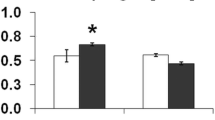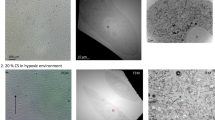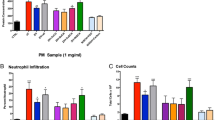Abstract
Cerium dioxide nanoparticles (CeO2 NPs) are an engineered nanomaterial (ENM) that possesses unique catalytic, oxidative, and reductive properties. Currently, CeO2 NPs are being used as a fuel catalyst but these properties are also utilized in the development of potential drug treatments for radiation and stroke protection. These uses of CeO2 NPs present a risk for human exposure; however, to date, no studies have investigated the effects of CeO2 NPs on the microcirculation following pulmonary exposure. Previous studies in our laboratory with other nanomaterials have shown impairments in normal microvascular function after pulmonary exposures. Therefore, we predicted that CeO2 NP exposure would cause microvascular dysfunction that is dependent on the tissue bed and dose. Twenty-four-hour post-exposure to CeO2 NPs (0–400 μg), mesenteric, and coronary arterioles was isolated and microvascular function was assessed. Our results provided evidence that pulmonary CeO2 NP exposure impairs endothelium-dependent and endothelium-independent arteriolar dilation in a dose-dependent manner. The CeO2 NP exposure dose which causes a 50 % impairment in arteriolar function (EC50) was calculated and ranged from 15 to 100 μg depending on the chemical agonist and microvascular bed. Microvascular assessments with acetylcholine revealed a 33–75 % reduction in function following exposure. Additionally, there was a greater sensitivity to CeO2 NP exposure in the mesenteric microvasculature due to the 40 % decrease in the calculated EC50 compared to the coronary microvasculature EC50. CeO2 NP exposure increased mean arterial pressure in some groups. Taken together, these observed microvascular changes may likely have detrimental effects on local blood flow regulation and contribute to cardiovascular dysfunction associated with particle exposure.










Similar content being viewed by others
References
Borm, P. J., Robbins, D., Haubold, S., Kuhlbusch, T., Fissan, H., Donaldson, K., et al. (2006). The potential risks of nanomaterials: A review carried out for ECETOC. Particle and Fibre Toxicology, 3, 11.
Hanson, N., Harris, J., Joseph, L. A., Ramakrishnan, K., & Thompson, T. EPA Needs to Manage Nanomaterial Risks More Effectively. 2011. Report No.: 12-P-0162.
Borm, P. J., & Muller-Schulte, D. (2006). Nanoparticles in drug delivery and environmental exposure: Same size, same risks? Nanomedicine (Lond), 1(2), 235–249.
Aitken, R. J., Chaudhry, M. Q., Boxall, A. B., & Hull, M. (2006). Manufacture and use of nanomaterials: Current status in the UK and global trends. Occupational Medicine (Lond), 56(5), 300–306.
Cassee, F. R., van Balen, E. C., Singh, C., Green, D., Muijser, H., Weinstein, J., et al. (2011). Exposure, health and ecological effects review of engineered nanoscale cerium and cerium oxide associated with its use as a fuel additive. Critical Reviews in Toxicology, 41(3), 213–229.
Cassee, F. R., Campbell, A., Boere, A. J., McLean, S. G., Duffin, R., Krystek, P., et al. (2012). The biological effects of subacute inhalation of diesel exhaust following addition of cerium oxide nanoparticles in atherosclerosis-prone mice. Environmental Research, 115, 1–10.
Preisler, E. J., Marsh, O. J., Beach, R. A., & McGill, T. C. (2001). Stability of cerium oxide on silicon studied by X-ray photoelectron spectroscopy. Journal of Vacuum Science and Technology B, 19(4), 1611–1618.
Geraets, L., Oomen, A. G., Schroeter, J. D., Coleman, V. A., & Cassee, F. R. (2012). Tissue distribution of inhaled micro- and nano-sized cerium oxide particles in rats: Results from a 28-day exposure study. Toxicology Science, 127(2), 463–473.
Yokel, R. A., Au, T. C., Macphail, R., Hardas, S. S., Butterfield, D. A., Sultana, R., et al. (2012). Distribution, elimination, and biopersistence to 90 days of a systemically introduced 30 nm ceria-engineered nanomaterial in rats. Toxicology Science, 127(1), 256–268.
Pairon, J. C., Roos, F., Sebastien, P., Chamak, B., Bd-Alsamad, I., Bernaudin, J. F., et al. (1995). Biopersistence of cerium in the human respiratory tract and ultrastructural findings. American Journal of Industrial Medicine, 27(3), 349–358.
Celardo, I., Traversa, E., & Ghibelli, L. (2011). Cerium oxide nanoparticles: A promise for applications in therapy. Journal of experimental therapeutics & oncology, 9(1), 47–51.
Heckert, E. G., Karakoti, A. S., Seal, S., & Self, W. T. (2008). The role of cerium redox state in the SOD mimetic activity of nanoceria. Biomaterials, 29(18), 2705–2709.
Colon, J., Herrera, L., Smith, J., Patil, S., Komanski, C., Kupelian, P., et al. (2009). Protection from radiation-induced pneumonitis using cerium oxide nanoparticles. Nanomedicine, 5(2), 225–231.
Kim, C. K., Kim, T., Choi, I. Y., Soh, M., Kim, D., Kim, Y. J., et al. (2012). Ceria nanoparticles that can protect against ischemic stroke. Angewandte Chemie (International ed. in English), 51(44), 11039–11043.
Stapleton, P. A., Minarchick, V. C., McCawley, M., Knuckles, T. L., & Nurkiewicz, T. R. (2012). Xenobiotic particle exposure and microvascular endpoints: A call to arms. Microcirculation, 19(2), 126–142.
Ma, J. Y., Zhao, H., Mercer, R. R., Barger, M., Rao, M., Meighan, T., et al. (2011). Cerium oxide nanoparticle-induced pulmonary inflammation and alveolar macrophage functional change in rats. Nanotoxicology, 5(3), 312–325.
Toya, T., Takata, A., Otaki, N., Takaya, M., Serita, F., Yoshida, K., et al. (2010). Pulmonary toxicity induced by intratracheal instillation of coarse and fine particles of cerium dioxide in male rats. Industrial Health, 48(1), 3–11.
Schwartzkopff, B., Mundhenke, M., & Strauer, B. E. (1998). Alterations of the architecture of subendocardial arterioles in patients with hypertrophic cardiomyopathy and impaired coronary vasodilator reserve: A possible cause for myocardial ischemia. Journal of the American College of Cardiology, 31(5), 1089–1096.
Prewitt, R. L., Rice, D. C., & Dobrian, A. D. (2002). Adaptation of resistance arteries to increases in pressure. Microcirculation, 9(4), 295–304.
Zweifach, B. W. (1984). Pressure-flow relations in blood and lymph microcirculation. In E. M. Renkin & C. C. Michel (Eds.), Handbook of physiology (pp. 251–308). Bethesda, MD: American Physiological Society.
Renkin, E. M. (1984). Control of microcirculation and blood-tissue exchange. In E. M. Renkin & C. C. Michel (Eds.), Handbook of physiology (pp. 627–687). Bethesda, MD: American Physiology Society.
Wingard, C. J., Walters, D. M., Cathey, B. L., Hilderbrand, S. C., Katwa, P., Lin, S., et al. (2011). Mast cells contribute to altered vascular reactivity and ischemia-reperfusion injury following cerium oxide nanoparticle instillation. Nanotoxicology, 5(4), 531–545.
Nalabotu, S. K., Kolli, M. B., Triest, W. E., Ma, J. Y., Manne, N. D., Katta, A., et al. (2011). Intratracheal instillation of cerium oxide nanoparticles induces hepatic toxicity in male Sprague-Dawley rats. International Journal of Nanomedicine, 6, 2327–2335.
LeBlanc, A. J., Cumpston, J. L., Chen, B. T., Frazer, D., Castranova, V., & Nurkiewicz, T. R. (2009). Nanoparticle inhalation impairs endothelium-dependent vasodilation in subepicardial arterioles. Journal of toxicology and environmental health. Part A, 72(24), 1576–1584.
Nurkiewicz, T. R., Porter, D. W., Barger, M., Millecchia, L., Rao, K. M., Marvar, P. J., et al. (2006). Systemic microvascular dysfunction and inflammation after pulmonary particulate matter exposure. Environmental Health Perspectives, 114(3), 412–419.
Tok, A. I. Y., Du, S. W., Boey, F. Y. C., & Chong, W. K. (2013). Hydrothermal synthesis and characterization of rare earth doped ceria nanoparticles. Materials science & engineering, 466, 223–229.
Nurkiewicz, T. R., Porter, D. W., Barger, M., Castranova, V., & Boegehold, M. A. (2004). Particulate matter exposure impairs systemic microvascular endothelium-dependent dilation. Environmental Health Perspectives, 112(13), 1299–1306.
Porter, D. W., Barger, M., Robinson, V. A., Leonard, S. S., Landsittel, D., & Castranova, V. (2002). Comparison of low doses of aged and freshly fractured silica on pulmonary inflammation and damage in the rat. Toxicology, 175(1–3), 63–71.
Sun, D., Messina, E. J., Kaley, G., & Koller, A. (1992). Characteristics and origin of myogenic response in isolated mesenteric arterioles. American Journal of Physiology, 263(5 Pt 2), H1486–H1491.
Chilian, W. M., Eastham, C. L., & Marcus, M. L. (1986). Microvascular distribution of coronary vascular resistance in beating left ventricle. American Journal of Physiology, 251(4 Pt 2), H779–H788.
Kotani, A., Jo, T., & Parlebas, J. C. (2013). Many-body effects in core-level spectroscopy of rare-earth compounds. Advances in Physics, 37, 8952–8961.
Burroughs, P., Hamnett, A., Orchard, A. F., & Thomton, G. (2013). Satellite structure in the X-ray photoelectron spectra of some binary and mixed oxides of lanthanum and cerium. Journal of the Chemical Society, Dalton Transactions, 17, 1686–1698.
Kumar, S., Butcher, K. S. A., & Tansley, T. L. (2013). X-ray photoelectron spectroscopy characterization of radio frequency reactively sputtered carbon nitride thin films. Journal of Vacuum Science and Technology A, 14(5), 2687–2692.
Grossi, L., & D’Angelo, S. (2005). Sodium nitroprusside: Mechanism of NO release mediated by sulfhydryl-containing molecules. Journal of Medicinal Chemistry, 48(7), 2622–2626.
Stone, K. C., Mercer, R. R., Gehr, P., Stockstill, B., & Crapo, J. D. (1992). Allometric relationships of cell numbers and size in the mammalian lung. American Journal of Respiratory Cell and Molecular Biology, 6(2), 235–243.
Galer, D. M., Leung, H. W., Sussman, R. G., & Trzos, R. J. (1992). Scientific and practical considerations for the development of occupational exposure limits (OELs) for chemical substances. Regulatory Toxicology and Pharmacology, 15(3), 291–306.
Phalen, R. F. (1984). Basic morphology and physiology of the respiratory tract, in inhalation studies: Foundations and techniques. Boca Raton: CRC Press.
Nurkiewicz, T. R., Porter, D. W., Hubbs, A. F., Stone, S., Moseley, A. M., Cumpston, J. L., et al. (2011). Pulmonary particulate matter and systemic microvascular dysfunction. Research Report/Health Effects Institute, 164, 3–48.
Menache, M. G., Miller, F. J., & Raabe, O. G. (1995). Particle inhalability curves for humans and small laboratory animals. Annals of Occupational Hygiene, 39(3), 317–328.
LeBlanc, A. J., Moseley, A. M., Chen, B. T., Frazer, D., Castranova, V., & Nurkiewicz, T. R. (2010). Nanoparticle inhalation impairs coronary microvascular reactivity via a local reactive oxygen species-dependent mechanism. Cardiovascular Toxicology, 10(1), 27–36.
Stapleton, P. A., Minarchick, V. C., Cumpston, A. M., McKinney, W., Chen, B. T., Sager, T. M., et al. (2012). Impairment of coronary arteriolar endothelium-dependent dilation after multi-walled carbon nanotube inhalation: A time-course study. International Journal of Molecular Sciences, 13(11), 13781–13803.
Courtois, A., Andujar, P., Ladeiro, Y., Baudrimont, I., Delannoy, E., Leblais, V., et al. (2008). Impairment of NO-dependent relaxation in intralobar pulmonary arteries: Comparison of urban particulate matter and manufactured nanoparticles. Environmental Health Perspectives, 116(10), 1294–1299.
Straub, A. C., Lohman, A. W., Billaud, M., Johnstone, S. R., Dwyer, S. T., Lee, M. Y., et al. (2012). Endothelial cell expression of haemoglobin alpha regulates nitric oxide signalling. Nature, 491(7424), 473–477.
Park, E. J., Choi, J., Park, Y. K., & Park, K. (2008). Oxidative stress induced by cerium oxide nanoparticles in cultured BEAS-2B cells. Toxicology, 245(1–2), 90–100.
Driscoll, K. E., Costa, D. L., Hatch, G., Henderson, R., Oberdorster, G., Salem, H., et al. (2000). Intratracheal instillation as an exposure technique for the evaluation of respiratory tract toxicity: Uses and limitations. Toxicological Sciences, 55(1), 24–35.
He, X., Zhang, H., Ma, Y., Bai, W., Zhang, Z., Lu, K., et al. (2010). Lung deposition and extrapulmonary translocation of nano-ceria after intratracheal instillation. Nanotechnology, 21(28), 285103.
Acknowledgments
The authors would like to thank Carroll McBride and Kimberly Wix for their expert technical assistance in this study. The authors would also like to thank Katarzyna Sabolsky for assistance with the TEM characterization of the CeO2 nanoparticles. This work is supported by the National Institutes of Health RO1-ES015022, RC1-ES018274 (TRN), F32-ES023435 (PAS) and the National Science Foundation Cooperative Agreement-1003907 (TRN and VCM).
Author information
Authors and Affiliations
Corresponding author
Additional information
Disclaimer The findings and conclusions in this report are those of the authors and do not necessarily represent the views of the National Institute for Occupational Safety and Health.
Rights and permissions
About this article
Cite this article
Minarchick, V.C., Stapleton, P.A., Porter, D.W. et al. Pulmonary Cerium Dioxide Nanoparticle Exposure Differentially Impairs Coronary and Mesenteric Arteriolar Reactivity. Cardiovasc Toxicol 13, 323–337 (2013). https://doi.org/10.1007/s12012-013-9213-3
Published:
Issue Date:
DOI: https://doi.org/10.1007/s12012-013-9213-3




